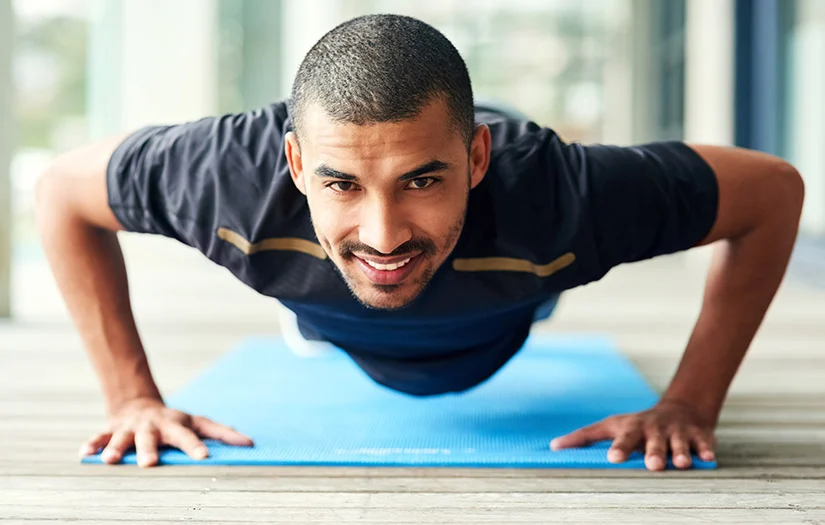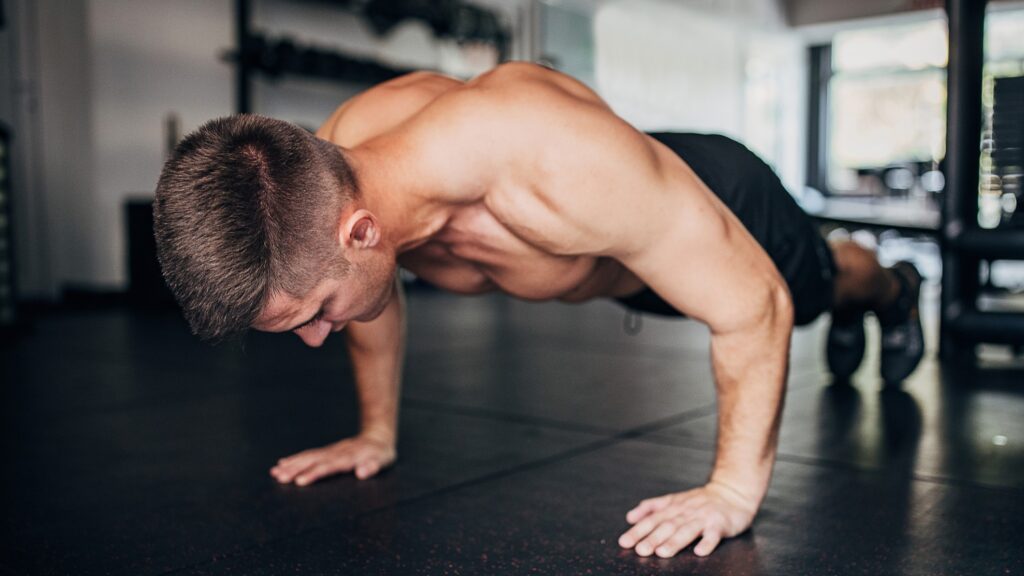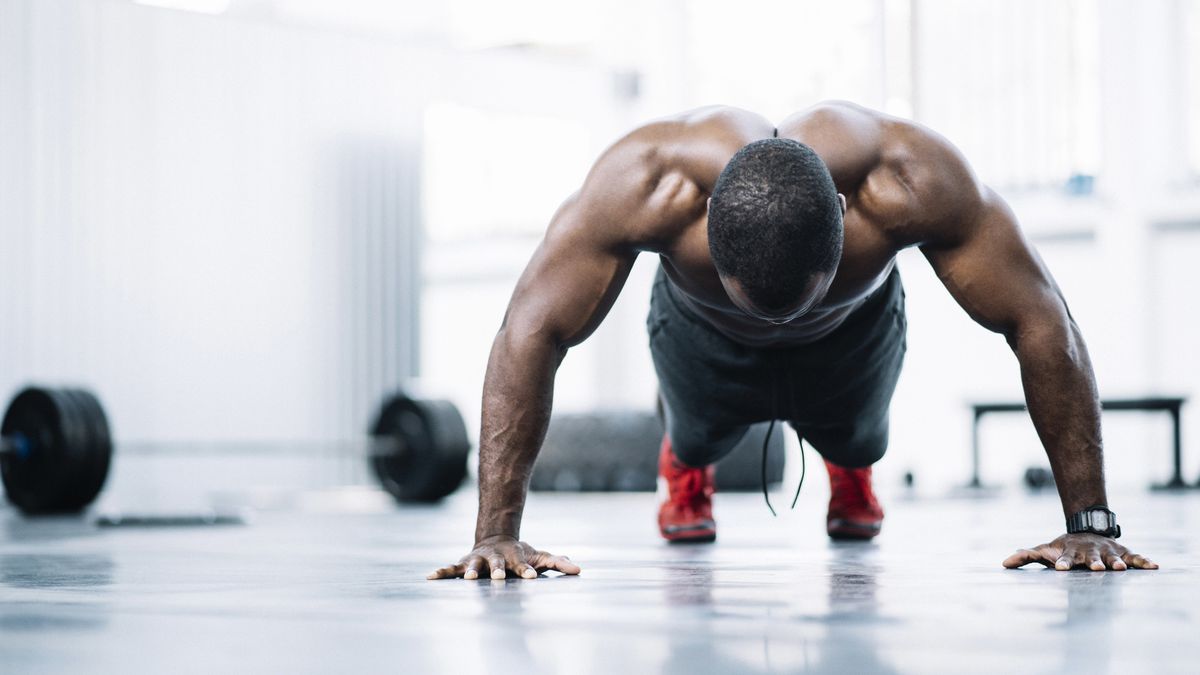The number of push-ups per day needed for a bigger chest depends on various factors, including your fitness level, goals, and overall workout routine. As a general starting point, doing 3 sets of 10-15 push-ups per day can help beginners build chest strength and endurance. Over time, you should progressively increase the number of push-ups, sets, or intensity to continue stimulating chest muscle growth.
For more advanced individuals, a target of 100 or more push-ups daily, spread throughout the day, can be challenging and effective for chest development. It’s essential to maintain proper form, ensure gradual progression, and allow sufficient recovery time between workouts to prevent overtraining.
What Are The Benefits Of Doing Push-Ups?

Push-ups are versatile and effective bodyweight exercises that offer a wide range of benefits for your physical and mental well-being. Here are some of the key advantages of incorporating push-ups into your fitness routine
Chest Development: Push-ups are one of the most effective exercises for strengthening and developing the chest muscles. This not only enhances the aesthetic appeal of a well-defined chest but also contributes to improved upper body strength.
Full-Body Workout: While push-ups primarily target the chest, they engage a variety of muscle groups, offering a comprehensive full-body workout. The triceps, shoulders, and upper back muscles are all activated during a push-up, promoting a balanced upper body strength.
Convenience: One of the key advantages of push-ups is their simplicity and convenience. They require no equipment or gym membership, and you can perform them practically anywhere, be it at home, in a park, or even during a travel break.
Improved Posture: As push-ups strengthen the chest and upper back muscles, they play a crucial role in improving posture. A strong upper body can help counteract the negative effects of prolonged sitting and hunching over screens.
Increased Endurance: Regular push-ups build muscular endurance, allowing you to perform various exercises and activities for longer durations. This can translate to improved athletic performance and reduced fatigue in daily tasks.
Enhanced Core Strength: Push-ups are not just an upper body exercise; they also engage the core muscles to stabilize your body. A strong core contributes to better balance and posture.
Versatility: Push-ups offer versatility through different variations. Wide-grip push-ups emphasize the chest, while close-grip ones target the triceps. Decline push-ups engage the lower chest, providing a well-rounded upper body workout.
Cardiovascular Health: When performed at high intensity as part of a circuit or HIIT (High-Intensity Interval Training), push-ups can elevate your heart rate and provide cardiovascular benefits. This adds an extra dimension to their overall advantages.
Weight Management: Push-ups, like any exercise, help burn calories. Incorporating them into your fitness routine can assist in weight management and fat loss.
Enhanced Mental Toughness: Consistency and discipline are essential for mastering push-ups. Building a push-up routine fosters mental resilience and a sense of accomplishment as you achieve fitness goals.
Injury Prevention: Strengthening various muscle groups, particularly the shoulders and core, reduces the risk of injuries during sports, workouts, and daily activities.
Improved Pushing Strength: Push-ups mimic the pushing motions required in everyday tasks, such as pushing doors, lifting objects, or even participating in sports like basketball or volleyball.
Increased Metabolism: Building lean muscle through regular strength training, including push-ups, can boost your metabolism. This results in more efficient calorie burning, even at rest.
Functional Fitness: Push-ups contribute to functional fitness by simulating real-life movements, making everyday tasks and activities easier to perform. This functional strength can greatly enhance one’s quality of life.
No Cost: Push-ups require no special equipment or investment, making them an accessible form of exercise for people of all fitness levels.
What Are The Types of Push-Ups for Chest Development?
Chest development can be enhanced by incorporating various types of push-ups into your workout routine. Different push-up variations target the chest muscles from multiple angles and can help you achieve a well-rounded chest
Standard Push-Ups
Standard push-ups are the foundation of chest development exercises. They engage the overall chest, triceps, and shoulders. Maintain a plank position with hands shoulder-width apart, and lower your chest toward the ground.
Wide-Grip Push-Ups
To target the outer chest, perform wide-grip push-ups by positioning your hands wider than shoulder-width. This variation enhances the stretch and engagement of the pectoral muscles.
Close-Grip Push-Ups
Bringing your hands closer together (inside shoulder width) shifts the focus to the triceps and inner chest. Close-grip push-ups are ideal for building triceps strength.
Decline Push-Ups
Elevating your feet on a bench or step platform increases the resistance on the lower chest. This variation challenges the chest muscles from a different angle and helps in developing the lower pectorals.
Incline Push-Ups
Placing your hands on an elevated surface, such as a bench, with your feet on the ground targets the upper chest. Incline push-ups are excellent for developing the upper chest.
Diamond Push-Ups
To engage the triceps and inner chest, perform diamond push-ups by placing your hands close together, forming a diamond shape with your thumbs and index fingers.
Plyometric Push-Ups
Plyo push-ups involve explosively pushing off the ground, promoting fast-twitch muscle fiber engagement. These are valuable for building power and explosiveness in the chest.
One-Arm Push-Ups
One-arm push-ups are an advanced variation that requires significant chest strength and balance. It’s a unilateral exercise that challenges chest and core stability.
Fist Push-Ups
Performing push-ups on your closed fists can provide a deeper range of motion and engage the chest muscles differently. This variation can also alleviate wrist discomfort.
Medicine Ball Push-Ups
Placing one hand on a medicine ball while performing push-ups creates an unstable surface. This instability challenges chest stability and balance, working the chest muscles in a unique way.
Push-Up Variations with Weight
Adding weight plates or wearing a weighted vest increases the resistance and intensity of push-ups. Weighted push-ups are effective for enhancing chest muscle growth.
Bosu Ball Push-Ups
Using a Bosu ball with the flat side down adds an element of instability. It engages chest stability and core muscles as you work to maintain balance during the exercise.
Clapping Push-Ups
After each push-up, explode off the ground and clap your hands in mid-air. Clapping push-ups require explosiveness and recruit the chest muscles for power and speed.
How Does Nutrition Impact Chest Development in Push-Ups?
Nutrition plays a vital role in achieving your fitness goals, including developing a strong chest through push-ups.
First and foremost, protein is essential for muscle growth and repair. It provides the building blocks (amino acids) needed for muscle development. Include lean sources of protein such as chicken, fish, lean beef, tofu, and legumes in your diet.
To build muscle, you need to consume enough calories to support your workouts and recovery. Maintaining a slight caloric surplus (more calories consumed than burned) can aid in muscle growth. Monitor your calorie intake and adjust it according to your goals.
The number of calories required to support muscle growth varies based on individual factors like age, gender, weight, activity level, and body composition.
As a general guideline, a surplus of 250-500 calories per day beyond what you need to maintain your current weight is often recommended.
In addition to calorie intake, the quality of your food choices matters significantly. Protein is a crucial component for muscle development, so it’s important to aim for a daily intake of 1.2-1.7 grams of protein per kilogram of body weight.
Furthermore, a balanced diet should include complex carbohydrates and healthy fats to provide the necessary energy and nutrients for muscle growth.
Furthermore, carbohydrates are your body’s primary energy source. They fuel your workouts, enabling you to perform more push-ups and work your chest effectively. Opt for complex carbohydrates like whole grains, fruits, and vegetables.
Also, fats are essential for overall health and hormone production. Include sources of healthy fats such as avocados, nuts, seeds, and olive oil in your diet.
However, proper hydration is often underestimated. Water is vital for muscle function and recovery. Dehydration can lead to muscle cramps and reduced exercise performance.
Aim to consume 16-24 ounces of water about 2-3 hours before you start exercising. During your workout, drink about 8 ounces of water every 20-30 minutes. After your workout, try to have 16-24 ounces of water within 2 hours to replenish lost fluids and support your recovery.
As well as. ensure you get a variety of vitamins and minerals through a balanced diet. These micronutrients play a role in muscle function, energy production, and overall health.
Consider the timing of your meals. Consuming a source of protein and carbohydrates after your workout can aid in muscle recovery.
It’s important to remember, that high sugar and processed food intake can lead to unwanted weight gain and may hinder muscle development. Opt for whole, unprocessed foods.
Lastly, nutrition is highly individual. Your needs may differ from someone else’s based on factors like age, activity level, and goals. Consulting with a registered dietitian or nutritionist can help you create a tailored nutrition plan.
How to do a proper push-up?
Performing a proper push-up is essential to maximize the effectiveness of the exercise and avoid potential injury. Here’s a step-by-step guide on how to do a proper push-up
Starting Position
- The starting position for a push-up is crucial. Begin by placing your hands slightly wider than shoulder-width apart on the ground.
- Then, extend your legs straight behind you, supporting your body weight on your toes.
- Remember, your body should form a straight line from your head to your heels, creating a strong plank-like position.
Body Alignment
- Maintain a neutral head position. Keep your head aligned with your spine, so your gaze is directed toward the ground a few inches in front of you. Avoid looking up or craning your neck.
- Engage your core muscles by tightening your abdominal muscles and glutes. This core engagement helps stabilize your body throughout the push-up.
Descent
- As you begin to lower your body, initiate the movement by bending your elbows.
- Keep your elbows close to your sides, rather than allowing them to flare out. This ensures that your chest, triceps, and shoulders are the primary muscle groups engaged.
- Lower your body until your chest is just above the ground, or as far down as your strength allows. The exact depth may vary depending on your fitness level.
Ascent
- Push through your palms and extend your arms to return to the starting position.
- Your body should move as a single unit, with your core muscles helping to stabilize your spine.
Breathing
- Inhale as you lower your body toward the ground. This inhalation prepares your body for the effort required during the descent.
- Exhale as you push up from the ground. Exhaling during the ascent assists in maintaining stability and control.
Repetition
- Complete the desired number of repetitions, ensuring that your form remains consistent throughout.
Tips for Proper Push-Ups
- Keep your body in a straight line. Avoid arching your back or allowing your hips to sag.
- Maintain a strong core engagement to support your spine and prevent your hips from dropping.
- If you’re a beginner, it’s perfectly acceptable to start with knee push-ups, where you rest your knees on the ground while maintaining proper form.
- Focus on quality over quantity. It’s more important to perform a few perfect push-ups than to rush through a larger number with poor form.
- Gradually increase the challenge by progressing to more difficult push-up variations as your strength improves.
What Are the Most Common Push-Up Mistakes and How to Avoid Them?

Avoiding common push-up mistakes is essential to maximize the benefits and prevent injury. Here are some errors to steer clear of
Poor Alignment: Maintain a straight line from head to heels. Avoid arching your back or letting your hips sag. This ensures proper muscle engagement and reduces strain on your lower back.
Hand Placement: Ensure your hands are positioned slightly wider than shoulder-width apart. Placing them too close can strain your wrists, and going too wide may stress your shoulders.
Elbow Position: Keep your elbows close to your sides as you descend. Allowing them to flare out can lead to unnecessary shoulder strain.
Incomplete Range of Motion: Perform full push-ups where your chest hovers just above the ground. Incomplete reps limit the effectiveness of the exercise.
Neck Alignment: Avoid craning your neck upward or allowing it to drop too low. Keep your head in line with your spine to prevent neck strain.
Breath Holding: Breathe naturally throughout the exercise. Holding your breath can lead to dizziness and reduced performance.
Speed Over Form: Quality trumps quantity. Focus on proper form rather than rushing through push-ups. Slow, controlled movements are more effective.
Ignoring Rest: Allow your muscles to recover between sets. Overtraining can lead to decreased strength and increased injury risk.
Not Adapting: Adjust your push-up difficulty as your strength increases. Progress to more challenging variations rather than sticking to the same routine.
By avoiding these common mistakes, you can perform push-ups safely and effectively, leading to better chest development and overall fitness.
FAQ
Can I get a big chest with pushups?
Yes, you can develop a bigger chest with push-ups, especially if you perform them with proper form and progressively increase the challenge.
Will 100 pushups a day make my chest bigger?
Doing 100 push-ups a day can help increase chest size to some extent, but for significant muscle growth, it’s advisable to incorporate a variety of chest exercises and progressively overload the muscles.
How many sets for chest push day?
The number of sets for a chest push day can vary based on your fitness level and goals. Typically, 3-5 sets per exercise, with 3-5 different exercises, is a common starting point.
Is 5 chest exercises too much?
Five chest exercises may be excessive for a single workout. Focusing on 2-4 different chest exercises per session allows you to target the muscles effectively without overloading them.
How to get a bigger chest?
To get a bigger chest, combine compound exercises like bench presses and push-ups with isolation exercises like chest flyes. Ensure progressive overload, maintain a balanced diet, and get adequate rest.
Why is my chest not growing?
A lack of chest growth can be due to various factors, including inadequate nutrition, insufficient training intensity, or not allowing enough time for recovery and muscle repair.
Is it hard to build a big chest?
Building a big chest requires dedication, consistency, and time. It can be challenging, but with the right training and nutrition, significant progress is achievable.
How to get a bigger chest in 30 days?
To make noticeable chest gains in 30 days, focus on a targeted chest workout routine, increase training intensity, consume adequate protein, and ensure sufficient rest and recovery.
Is 2 chest days enough?
Having two chest-focused workout days per week can be effective for chest development. However, the quality of your workouts and other factors like diet and rest also play a role.
How do I shape my chest?
To shape your chest, include a variety of chest exercises in your routine to target different areas of the chest, such as upper, lower, and inner chest muscles. Ensure proper form and progressive overload for best results.
Final words
Achieving a big and strong chest through push-ups requires dedication, consistency, and the right approach. While the number of push-ups per day may vary based on individual fitness levels and goals, it’s important to focus on quality over quantity. Maintaining proper form and gradually increasing the challenge with different push-up variations are key.
Remember, nutrition and overall fitness also play significant roles in chest development. A well-balanced diet and a holistic exercise routine will complement your push-up efforts. By staying committed and being mindful of your body’s needs, you can work toward that impressive chest you desire. So, keep pushing up and watch your chest grow stronger and more defined over time.



